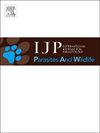Fatal babesiosis in a free-ranging iberian wolf co-infected with Hepatozoon canis and Leishmania infantum: Epidemiological implications for the cantabrian wolf population
IF 2.2
3区 医学
Q3 ECOLOGY
International Journal for Parasitology-Parasites and Wildlife
Pub Date : 2025-05-13
DOI:10.1016/j.ijppaw.2025.101080
引用次数: 0
Abstract
Health surveillance of large carnivores, such as the Iberian wolf (Canis lupus signatus), allows the early detection of emerging and established pathogens in natural environments, due to their position in the top of the food chain. In 2022, the carcass of a wild wolf was found in Cantabria, Northwest Spain. A complete post-mortem investigation, including full necropsy, histopathological and molecular analysis concluded that the cause of death was a systemic hemolytic disease caused by Babesia canis. Furthermore, the wolf was co-infected with Hepatozoon canis and Leishmania infantum. Consequently, a molecular investigation of Babesia spp., Hepatozoon spp., Leishmania spp., Ehrlichia spp., Anaplasma spp., and Rickettsia spp. was performed in the Cantabrian wolf population (n = 91). The prevalences found were 6.3 % (5/79) for B. canis, 96.3 % (78/81) for H. canis, and 23.8 % (21/88) for L. infantum. None of the wolves were positive to Ehrlichia spp., Anaplasma spp., or Rickettsia spp. The co-infection prevalences were also investigated. To our knowledge, this is the first description of a fatal babesiosis in a wild wolf, as well as the first detection of B. canis and H. canis infection in the Iberian wolf population. We have found a low B. canis prevalence, while the H. canis prevalence is the highest recorded so far. The detection of L. infantum highlights the circulation of this zoonotic pathogen in a non-endemic region.

同时感染犬肝虫病和幼利什曼原虫的自由放养伊比利亚狼的致命巴贝斯虫病:对伊比利亚狼种群的流行病学意义
对伊比利亚狼(Canis lupus signatus)等大型食肉动物的健康监测,由于它们处于食物链的顶端,可以在自然环境中早期发现新出现的和已建立的病原体。2022年,在西班牙西北部的坎塔布里亚发现了一只野狼的尸体。完整的尸检调查,包括全面尸检、组织病理学和分子分析,得出的结论是,死亡原因是由犬巴贝斯虫引起的全身性溶血性疾病。此外,狼同时感染了犬肝虫和幼利什曼原虫。因此,我们对坎塔布里亚狼种群(n = 91)进行了巴贝斯虫、肝虫、利什曼原虫、埃利希氏体、无形体和立克次体的分子调查。犬b型、犬h型和婴幼儿l型的感染率分别为6.3%(5/79)、96.3%(78/81)和23.8%(21/88)。所有狼均未检出埃利希体、无形体和立克次体,并调查了它们的共感染流行情况。据我们所知,这是首次在野狼中发现致命性巴贝斯虫病,也是首次在伊比利亚狼种群中发现犬b型和犬h型感染。我们发现犬b患病率较低,而犬h患病率是迄今为止记录的最高水平。婴儿乳杆菌的检测突出了这种人畜共患病原体在非流行地区的传播。
本文章由计算机程序翻译,如有差异,请以英文原文为准。
求助全文
约1分钟内获得全文
求助全文
来源期刊

International Journal for Parasitology-Parasites and Wildlife
Medicine-Infectious Diseases
CiteScore
3.80
自引率
5.60%
发文量
113
审稿时长
45 days
期刊介绍:
The International Journal for Parasitology: Parasites and Wildlife (IJP-PAW) publishes the results of original research on parasites of all wildlife, invertebrate and vertebrate. This includes free-ranging, wild populations, as well as captive wildlife, semi-domesticated species (e.g. reindeer) and farmed populations of recently domesticated or wild-captured species (e.g. cultured fishes). Articles on all aspects of wildlife parasitology are welcomed including taxonomy, biodiversity and distribution, ecology and epidemiology, population biology and host-parasite relationships. The impact of parasites on the health and conservation of wildlife is seen as an important area covered by the journal especially the potential role of environmental factors, for example climate. Also important to the journal is ''one health'' and the nature of interactions between wildlife, people and domestic animals, including disease emergence and zoonoses.
 求助内容:
求助内容: 应助结果提醒方式:
应助结果提醒方式:


